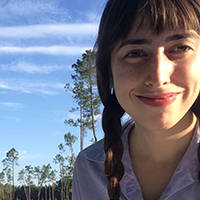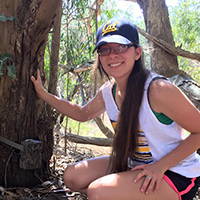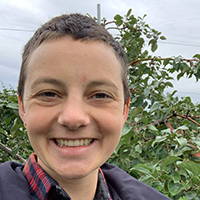These talks, held both days of the Spring Symposium, provide an opportunity for ecology-focused graduate students and postdoctoral scientists to share their research.
Day 1 Presentations
2–3 p.m. Tuesday, April 27
Effects of Wolves on Elk Habitat Use in Wisconsin
Jennifer Merems – Forest and Wildlife Ecology

In systems where they co-occur, predation by wolves (Canis lupus) can be an important driver of elk (Cervus canadensis) population dynamics and habitat use. Most studies on the impacts of wolves on elk come from western North America, where elk populations have long been established and predator-prey communities are more diverse.
In the Great Lakes region, effects of wolves on elk are poorly understood due to a relatively small number of established elk herds existing with wolves. Because wolf densities tend to be much higher than those in western regions, wolves may have an increased capacity to limit elk movement on the landscape. In this study, we sought to identify the environmental variables elk are selecting.
Overall, we found that elk avoid areas of increased predation risk. This information is a stepping-stone for further research into identifying the quality and quantity of forage available in areas heavily used by elk which will allow us to understand the degree to which predation risk influences habitat use in northern Wisconsin. This will help to determine whether wolves are displacing elk from high quality habitats and how that may impact elk populations.
Past and Present Disturbances Mediate Ungulate Antipredator Behavior and Herbivory in Longleaf Pine Woodlands
Savannah L. Bartel – Integrative Biology

Antipredator behavior affects prey fitness, population dynamics, and can modify the strength of ecological interactions. Antipredator behavior can be particularly important in the context of environmental change because many animals can exhibit multiple forms of antipredator behavior (e.g., vigilance vs. temporal avoidance), and changes in the environment may alter the efficacy of a particular form of antipredator behavior. Understanding the link between environmental conditions and antipredator behavior is challenging because habitats often experience multiple types of environmental change.
For example, fire is a contemporary disturbance that leads to dramatic changes in many terrestrial habitats. These same habitats may have also experienced past disturbances that leave lasting legacies on habitat structure, such as past agricultural land use. It is not clear how these past and present disturbances affect the use of temporal avoidance vs. vigilance antipredator behaviors. Since, ungulate herbivores have the potential to generate large-scale, long-term impacts on habitats through top-down control of plant communities, changes in ungulate antipredator behavior may explain spatial patterns plant communities.
We examined whether variation in disturbance regimes generate differences in ungulate antipredator behavior by using cameras to measure white-tailed deer vigilance and diel activity patterns in longleaf pine woodland habitat across 24 sites spanning 80,000 ha that vary in past land use and contemporary fire regime. We examined if disturbance regimes modified the impact of herbivory on plant communities by using long-term deer exclosures at 26 sites.
Regardless of land-use history, woodlands with high fire frequencies had 4x less vegetation cover, generating riskier habitats for deer than woodlands with low fire frequencies. In post-agricultural woodlands, deer were significantly more vigilant in woodlands with high fire frequencies than in those with low fire frequencies. There was no effect of fire regime on deer vigilance in nonagricultural woodlands.
Conversely, diel activity patterns of deer in nonagricultural woodlands were affected by fire regime, such that deer activity was nocturnal in nonagricultural woodlands with low fire frequencies but crepuscular in nonagricultural woodlands with high fire frequencies. There was no effect of fire on deer activity patterns in post-agricultural woodlands. Plant communities were impacted by both land-use history and deer herbivory, but the effects of herbivory were contingent upon fire regime. Herbivory led to reduced plant species richness in low-fire sites but had no effect in high-fire sites.
These results suggest that ungulate antipredator behavior may vary spatially depending upon past land use and contemporary fire regime. Hence, past land use may generate “landscapes of fear” that persist for decades after agricultural disturbance, and explicit consideration of both past and present disturbance may enable more accurate predictions of animal behavior in the dynamic landscapes of the Anthropocene. Moreover, these findings suggest that understanding the effects of disturbances on animal behavior may explain spatial patterns in plant communities.
Where Did the Coyote Cross the Road? Characteristics of Urban Canid Road Crossing Sites and Implications for Urban Wildlife Management
Morgan Farmer – Forest and Wildlife Ecology

Within urban landscapes, vehicle mortality is a major cause of death for many wildlife species, and wildlife-vehicle collisions are a safety concern for humans. As such, identifying characteristics of roads and surrounding habitat that wildlife may select for when crossing roads is essential for effective mitigation of wildlife-vehicle collisions. Our objectives were to determine whether coyotes and red foxes selectively cross roads at specific locations and times, and if so, to identify specific road and roadside habitat characteristics that coyotes and red foxes select for road crossings.
Within Madison, Wisconsin, we captured coyotes and red foxes between November and March 2017-2019 using cable restraints. After chemical immobilization, we fit each captured individual with a radio collar (LiteTrack Iridium 360 for coyotes, LiteTrack Iridium 130-150 for red foxes; Lotek, Ontario, Canada). We also used data from coyotes and foxes previously captured and monitored in Madison from January 2015 to April 2016. We programmed each collar to collect location fixes at one-hour intervals between 9 pm and 4 am for coyotes and 1 am and 4 am for red foxes.
Based on the GPS locations, we identified every road crossing made by each individual and recorded the date and time of the crossing, in addition to the individual’s sex, the number of lanes, speed limit, traffic volume, and roadside habitat type. We mapped each road crossing location and used hotspot analysis to identify hotspots of road crossings within Madison, and then we used a step selection function to identify specific road characteristics related to coyote and red fox road crossing sites.
In total, we have collected data from seventeen coyotes and fifteen red foxes and recorded approximately 14,000 locations. Identifying characteristics of roads that wildlife select for road crossing sites can inform wildlife-vehicle collision mitigation efforts as well as wildlife-friendly urban planning.
The Role of Decreased Snow Cover on Greenhouse Gas Dynamics in Northern Wisconsin Small Lakes
Adrianna Gorsky – Integrative Biology

North temperate lakes can be large sources of atmospheric greenhouse gases, such as carbon dioxide and methane. Most studies to date have focused on summer measurements of gas emissions, even though a substantial portion of annual emissions can occur during spring ice melt. With climate change, winter conditions are rapidly changing with forecasted decreases in spring snow cover and ice duration.
To investigate the effect of a winter with decreased snow cover on greenhouse gas emissions, we experimentally removed snowfall from a small dystrophic lake in northern Wisconsin. As a comparative study, we were able to explore the role of light in under-ice gas dynamics and spring emissions in dimictic lakes. We expected a reduction in snow to increase light penetration and potentially stimulate oxygen availability influencing carbon dynamics. Our study aims to improve the understanding of winter limnological processes and carbon cycling in the context of a changing climate.
Day 2 Presentations
4–5 p.m. Wednesday, April 28
Invasive Shrubs Generate Biotic Resistance to Invasive Worms
Carson Keller – Integrative Biology

Ecosystems often experience the contemporaneous invasion of multiple species; however, there is little understanding of the interactive effects that concurrent invasions have on trophic interactions (i.e., predator-prey and plant-herbivore). Modified plant-herbivore interactions can have direct consequences on native plant species survival, distribution, and population dynamics. Identifying variation in small mammal trophic interactions is critical to determining if native species actively resist (i.e., biotic resistance) or facilitate invasional success; biotic resistance can occur when native species alter their biotic interactions and behaviors in ways that prevent or resist invasions.
Invasive shrubs and earthworms can rapidly modify the habitat structure and community dynamics of an ecosystem and also have the potential to facilitate one another’s success. Increases in the habitat structure provided by invasive shrubs may exacerbate small mammal consumer pressure on native seeds, invasive earthworm cocoons, or both.
We used site-level experimental manipulation of invasive buckthorn (Rhamnus cathartica) to determine: (1) if changes in small mammal trophic interactions promote invasional meltdown (i.e., cofacilitation) or biotic resistance and (2) if invasive species mediate the consumer pressure experienced by native plant species. We quantified seed and cocoon removal by arthropods and small mammals for invasive jumping worm cocoons (Amynthas spp.) and three native herbaceous seeds species (A. canadensis, G. maculatum, C. thalictroides) of restoration interest.
We found that both cocoon and seed predation increased by over 20% when buckthorn was present relative to when buckthorn had been removed; however, the effect of buckthorn on seed predation varied by seed species. Small mammal cocoon and seed predation was greater than arthropod predation alone and significantly declined when buckthorn was removed. This pattern of consumer pressure was potentially driven by the substantially higher levels of white-footed mouse (Peromyscus leucopus) activity within buckthorn invaded plots.
Our results indicate that the habitat structure provided by invasive shrubs modifies small mammal trophic interactions generating biotic resistance to invasive earthworms. Failing to account for native species interactions may constrain our ability to predict the mechanisms leading to invasional success or failure and the ability of ecosystems to resist to multiple invasions.
Soil Bacterial Response to Fire Under High and Low Moisture Conditions in the Canadian Boreal Forest
Dana Johnson – Soil Science

The Canadian boreal forests hold large reservoirs of carbon in aboveground biomass and within the soil. Wildfires play an integral role in boreal forest ecosystems and carbon cycling by driving plant succession and releasing nutrients during organic matter combustion. In the face of changing wildfire regimes in boreal forests, there is a need to understand the effect of fire on soil microbial ecology and its impact on post-fire ecosystem recovery and global nutrient cycling.
In this study, we investigated fire effects on soil physical and chemical properties and soil bacterial communities under wet and dry moisture conditions by simulating wildfires in the lab, laboratory incubations, and high-throughput amplicon sequencing. We collected soil cores from 19 sites within Wood Buffalo National Park, located in Alberta and the Northwest Territories, Canada.
For each site, we subjected paired cores to low and high moisture conditions before applying a heat flux in a cone calorimeter. We tracked soil temperature during and after the burn treatment, and recorded soil pH, C:N, and moisture. We measured soil microbial respiration during a 5-week incubation and collected samples for high-throughput amplicon sequencing. We hypothesized that fire would cause a larger increase in soil pH and higher rates of bacteria mortality in dry soil than in wet soil and expect bacteria with the ability to form spores, with short replication times, and higher temperature tolerance thresholds to survive the burn and thrive in the weeks following the fire treatment.
During the fire treatments, temperatures within the dry cores ranged from 26.4 to 588.1 ºC. Temperatures within the wet cores did not exceed 44 ºC. Higher severity fires under dry conditions caused an increase in soil pH and decreased rates of soil respiration at 18 of the 19 sites, which could be driven by bacteria mortality at high temperatures during the fire treatments and by a reduction in easily-mineralizable C due to combustion. The response of soil bacterial community activity to wildfires is an important component of understanding and, ultimately, modeling carbon cycling in boreal forest ecosystems in the face of shifting wildfire regimes.
Next, we look to use high-throughput amplicon sequencing to investigate changes in bacterial community composition following the fire treatment and to identify specific bacteria well-suited to the post-fire environment.
Virus-Driven Metabolism: Characterizing and Quantifying an Overlooked Component of Biogeochemical and Community Level Dynamics
Kristopher Kieft – Bacteriology

Viruses are the most abundant biological entities on Earth, reside in every environment we’ve found life and infect all living organisms. Despite being simple shells of protein containing a small amount of nucleic acid, viruses (mainly those infecting bacteria) are capable of driving planet-wide biogeochemical cycling and influence the structures of entire food networks. Viruses also are pervasive human pathogens and cause detrimental losses on the agriculture and food industries.
Determining the ecology, diversity and interactions of viruses is vital to our understanding of how they shape the planet. Here, we explore how viruses can manipulate the metabolic properties of bacteria in microbial communities and the effects on biogeochemical cycling in diverse environments. Using a variety of metagenomic sequencing-based and isolated culture techniques, we show that viruses may be integral components of microbial and higher order communities.
Characterizing Microbial Community Dynamics Within Ant Fungus Gardens
Dr. Margaret W. Thairu – Bacteriology

Fungus-farming ants have emerged as a model system for studying complex symbiotic relationships. Within this multipartite symbiosis, the fungus garden acts as an external gut for the ants, processing indigestible plant material into easily utilized nutrients. Previous work has shown that fungus gardens not only consist of the symbiotic fungus that the ants feed on, Leucoagaricus spp., but also a diverse bacterial community dominated by the genera Burkholderia, Enterobacter, Klebsiella, Pantoea, and Pseudomonas which are commonly associated with gut microbiomes across diverse animal lineages.
Within the fungus garden, these bacteria are implicated in the degradation of plant defense compounds and aid in fixing nitrogen that the ants then use. Here we focus on Burkholderia and use in silico and in vitro methods to characterize secondary metabolites potentially important for symbiotic function. Focusing on the role that Burkholderia may play in the fungus garden microbiome is particularly compelling, as these bacteria are associated with a diversity of host microbiomes acting both pathogens and mutualists.
As Burkholderia typically have large genomes, with species devoting ~10% of their genome to the production of secondary metabolites such as antifungals and antibiotics; strains found within the fungus garden have the potential to be beneficial symbionts and produce a diversity of secondary metabolites. In turn these secondary metabolites may be co-opted to maintain the health of the garden. Overall, results of this study will help further our understanding of factors that have led to the formation and maintenance of a diverse microbial community.